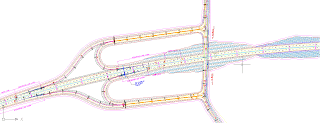For the last few years, La’o Hamutuk reported on the most expensive Government project in Timor-Leste’s history. The ill-conceived, poorly-planned, mismanaged and badly implemented national electricity project includes two heavy oil power plants and a high voltage grid. Even if there are no more cost overruns, this project will cost Timor-Leste more than $950 million dollars to construct ($443 million has already been spent) – plus hundreds of millions more for fuel, operation and maintenance.
Timorese policy-makers think big, and the electricity mega-project is about to be eclipsed by the South Coast Highway between Suai and Beacu, part of the Tasi Mane petroleum infrastructure corridor. Cars and 10-ton trucks will speed along its two carriageways at 100 km/hour, completing the 152-km trip in less than two hours.
Timor-Leste paid PT Virama Karya nearly a million dollars for a “Preliminary, Detailed Design and Environmental, Social and Economic Assessment” of this road, which was done in association with Multi Arch, LDA. A few weeks ago, the consultants presented their 75-volume report to the Government. They estimate construction costs at $9.2 million per kilometer (about 20% less than similar roads in Indonesia) for a total outlay of $1.39 billion.
The proposed 2012 State Budget describes some of the expenditures for this project, although we believe they are understated (see table at right). This total, $767 million, is about half of what Virama Karya says the road will cost. If may be intended to pay for just a single carriageway, as the Strategic Development Plan suggests that the lanes may be built one at a time.
La’o Hamutuk estimates that the total cost of the road during its 30-year life (including construction, loan interest, and maintenance) will be $1 billion for a single-carriageway road, and $1.7 billion if both carriageways are built.
Today, traffic along this route is less than 100 cars and trucks each day. If we optimistically assume tremendous growth due to the Tasi Mane project, this could increase by a factor of ten, to 1,000 per day. If the Virama Karya design is built and partly financed with concessional loans, each car or truck driving the length of the highway will benefit from a state subsidy of $156, more than a dollar per vehicle-kilometer. (Even if only one carriageway is built, Timor-Leste will have paid 60c for each vehicle-kilometer travelled, or $91 for a car which drives its length.)
One way to recover some of this money would be to charge tolls on this highway, although this seems unlikely given the Government’s decisions to reduce fuel and import taxes and to subsidize electricity users. If motorists paid tolls about the same as are charged in Indonesia (about 4¢/km for cars and 12¢/km for trucks), the state could recoup about 10% of its outlay.
The money which will be spent on this highway – more than $1,000 for each Timorese citizen and more than two years of our non-oil GDP – could do a lot for the education and health of our people, building human resources which could sustain Timor-Leste for generations. Petroleum revenues enable the “resource curse,” and petroleum-fueled vehicles justify an "Easy Street" for spending them.
20 October 2011
Subscribe to:
Post Comments (Atom)








The United States created the Interstate Highways, which increased commerce and travel efficiency, but made the country dependent on fossil fuels, and government subsidies to operate. Hateke ulu!
ReplyDelete